Michael J. Behe's Blog, page 87
April 3, 2022
Virus manipulates caterpillars into killing themselves
Is this an instance of evil intelligence in the world?:
Entomologists have long known that a group of insect viruses known as nucleopolyhedroviruses induce the larvae of moths to migrate to the top of plants before they die—a behavior which is thought to aid the virus’s transmission by enhancing its spread over the foliage and increasing the chances a new host will encounter it.
Alejandra Manjarrez, “Virus Alters Caterpillars’ Vision to Trick Them into Climbing” at The Scientist (March 25, 2022)
The suggestion is that, as the caterpillars are dying from the virus, the virus manipulates them to die in a place more convenient for itself.
Another aspect yet to be addressed is how behavioral modifications like the one observed in these caterpillars benefits the virus—if indeed it does—says University of British Columbia ecologist Judith Myers, who was not involved in the study. In the paper, the authors hypothesize that the death of caterpillars at elevated positions may favor viral transmission by bringing them closer to younger larvae, which spend more time at the upper parts of the plants than older animals. Based on experiments performed in Liu’s lab, the team says that younger larvae appear to be more vulnerable to the virus.
But as of yet, there isn’t clear evidence that the caterpillars’ climbs aid viral transmission. “It’s very hard to study the impact of this behavior on the spread of virus,” Myers explains. Still, she says future work should also address this part of the story.
Alejandra Manjarrez, “Virus Alters Caterpillars’ Vision to Trick Them into Climbing” at The Scientist (March 25, 2022)
The virus actually changes the insect’s behavior quite significantly:
NPVs are known to drive their caterpillar hosts to the top of plants before dying, whereas the more natural behavior is for the caterpillars to sink to the earth before pupating…
All of which means these nucleopolyhedroviruses appear to hijack the insects’ natural affinity for light and use it against them. The next question for scientists is exactly how these genes are manipulated by the virus – but that’s a story for another study.
David Nield, “How a Zombifying Virus Can Manipulate Caterpillars Into Killing Themselves” at ScienceAlert
The paper requires a fee or subscription.
You may also wish to read: Neuroscientist: Even viruses are intelligent. Antonio Damasio says, in the excerpt from his new book, that — based on the evidence — we cannot deny viruses “some fraction” of intelligence. Researchers who study viruses, including the one that causes COVID, note similarities between viral strategies and those of insects and animals.
Copyright © 2022 Uncommon Descent . This Feed is for personal non-commercial use only. If you are not reading this material in your news aggregator, the site you are looking at is guilty of copyright infringement UNLESS EXPLICIT PERMISSION OTHERWISE HAS BEEN GIVEN. Please contact legal@uncommondescent.com so we can take legal action immediately.Plugin by Taragana
Researchers: Tool patterns show that Neanderthals were declining before Homo sapiens arrived
Though we don’t know why. (The pop science version, we may recall, is that other human groups simply killed them off.):
The researchers examined over 5,000 remains of Châtelperronian tools from a site called Aranbaltza II in Barrika, in the Northern Iberian Peninsula, dating to around 45,500 years ago. Comparing this site with other nearby Neandertal tool sites, they document that the Châtelperronian system does not overlap in time with older Neandertal technologies in this region, suggesting that Châtelperronian tools were not developed from earlier Iberian technology, but instead originated elsewhere before migrating into the region. They also found that Châtelperronian tools appear earlier than the first Homo sapiens tools in the Iberian Peninsula.
Based on this evidence, the authors suggest that older Iberian Neandertal populations disappeared, taking their tool styles with them, and were replaced by different Neandertal groups using Châtelperronian tools, likely migrating from France, and these populations were in turn replaced by Homo sapiens. The researchers propose that these patterns of local Neandertal extinction and replacement will be an important area of future study, as they might have played a significant role in the decline and ultimate demise of Neandertals.
The authors add: “Neandertals with Châtelperronian technology occupied the Northern Iberian Peninsula ca. 43,000 years ago. This territory was unoccupied at the time, following the earlier disappearance of local Neandertal groups, along with their Mousterian technology.”
PLOS, “Tools reveal patterns of Neandertal extinction in the Iberian Peninsula” at ScienceDaily (March 30, 2022)
The paper is open access.
You may also wish to read: Neanderthal Man: The long-lost relative turns up again, this time with documents
Copyright © 2022 Uncommon Descent . This Feed is for personal non-commercial use only. If you are not reading this material in your news aggregator, the site you are looking at is guilty of copyright infringement UNLESS EXPLICIT PERMISSION OTHERWISE HAS BEEN GIVEN. Please contact legal@uncommondescent.com so we can take legal action immediately.Plugin by Taragana
Steve Meyer on why a supposed multiverse is no answer to the extreme fine-tuning of our universe

Here’s an excerpt from Steve Meyer’s chapter, “What is the evidence for intelligent design?” in The Comprehensive Guide to Science and Faith: Exploring the Ultimate Questions About Life and the Cosmos (2021)
The speculative cosmologies (such as inflationary cosmology and string theory) they propose for generating alternative universes invariably invoke mechanisms that themselves require fine-tuning, thus begging the question as to the origin of that prior fine-tuning. Indeed, all the various materialistic explanations for the origin of the fine-tuning — i.e., the explanations that attempt to explain the fine-tuning without invoking intelligent design — invariably invoke prior unexplained fine-tuning.
Improbability and Functional Specification
Moreover, the fine-tuning of the universe exhibits precisely those features — extreme improbability and functional specification — that invariably trigger an awareness of, and justify an inference to, intelligent design.6 Because the multiverse theory cannot explain fine-tuning without invoking prior fine-tuning, and because the fine-tuning of a physical system to accomplish a recognizable or propitious end is exactly the kind of thing we know intelligent agents do, it follows that intelligent design stands as the best explanation for the fine-tuning of the universe. And that makes intelligent design detectable in both the physical parameters of the universe and the information-bearing properties of life.
Stephen C. Meyer, “Anthropic Fine-Tuning as Evidence of Design” at Evolution News and Science Today (March 28, 2022)
Here are the rest of the excerpts from Meyer’s chapter.
You may also wish to read: Templeton tries to wish away fine-tuning of the universe.
Copyright © 2022 Uncommon Descent . This Feed is for personal non-commercial use only. If you are not reading this material in your news aggregator, the site you are looking at is guilty of copyright infringement UNLESS EXPLICIT PERMISSION OTHERWISE HAS BEEN GIVEN. Please contact legal@uncommondescent.com so we can take legal action immediately.Plugin by Taragana
April 2, 2022
At Mind Matters News: NASA develops a scale for assessing the chances of ET life
We’ve come a long way from mere snatches of (maybe) information to the need for standards in evaluating the expected incoming mass:
The main problem is that evidence that might suggest life could easily be a non-biological process:
Consider Jupiter’s moon Europa. A large asteroid impact could have volatilized ice on the surface, creating a water vapor atmosphere. Radiation from Jupiter could then have split the water molecules into oxygen and hydrogen, leaving the lighter hydrogen to escape to space and the heavier oxygen to be left behind. Just as with Europa, the discovery of oxygen in an exoplanet’s atmosphere, exciting at first, could turn out to have a purely physical explanation.
Finding large amounts of big organic molecules like chlorophyll in an alien atmosphere would be more exciting, since they are not known to form under abiotic conditions. By itself, however, that wouldn’t likely be proof enough. There would always be the nagging suspicion that some unknown non-biological chemistry is responsible.
Dirk Schulze-Makuch, “Alien life: What would constitute “smoking gun” evidence?” at Big Think (March 29, 2022)
But, with so many new exoplanets coming into the view of the powerful new telescopes, a scale for assessing claims is an alternative to endless inconclusive buzz. NASA, for one, is on board with that:
The scale contains seven levels, reflective of the winding, complicated staircase of steps that would lead to scientists declaring they’ve found life beyond Earth. As an analogy [to the Confidence of Life Detection scale], Green and colleagues point to the Technology Readiness Level scale, a system used inside NASA to rate how ready a spacecraft or technology is to fly. Along this spectrum, cutting-edge technologies such as the Mars helicopter Ingenuity begin as ideas and develop into rigorously tested components of history-making space missions.
The authors hope that in the future, scientists will note in published studies how their new astrobiology results fit into such a scale. Journalists could also refer to this kind of framework to set expectations for the public in stories about new scientific results, so that small steps don’t appear to be giant leaps.
Elizabeth Landau, “Are We Alone in the Universe? NASA Calls for New Framework” at NASA Astrobiology (October 27, 2021)
James Green, NASA’s chief scientist spearheaded the scale.
News, “NASA develops a scale for assessing the chances of ET life” at Mind Matters News (April 2, 2022)
Takehome: The idea is to give media some idea of the level of confidence in what the apparent signal might be telling us — biological activity or just chemistry?
You may also wish to read:
The Drake equation at 60 years: The second most famous equation After e = mc2. New technology is improving our ability to search the skies for signs of possible extraterrestrial civilizations. Whatever the fate of current ET detection projects, a design filter of the sort proposed beats squabbling about the probability without collecting any data.
and
Astrophysicist: Stop looking for extraterrestrial civilizations. And accept that ‘Oumuamua was a natural object, though a very mysterious one. Paul Sutter is not saying that ET isn’t out there but that evidence of biosignatures (life) is more useful than technosignatures (intelligent life).
Copyright © 2022 Uncommon Descent . This Feed is for personal non-commercial use only. If you are not reading this material in your news aggregator, the site you are looking at is guilty of copyright infringement UNLESS EXPLICIT PERMISSION OTHERWISE HAS BEEN GIVEN. Please contact legal@uncommondescent.com so we can take legal action immediately.Plugin by Taragana
Francis Schaeffer’s “line of despair” model of our civilisation’s intellectual history:
We can adapt Francis Schaeffer’s themes, looking back to the Christian Synthesis of the heritage of Jerusalem, Greece and Rome, and the onward flow of ideas and cultural agendas since Paul of Tarsus:
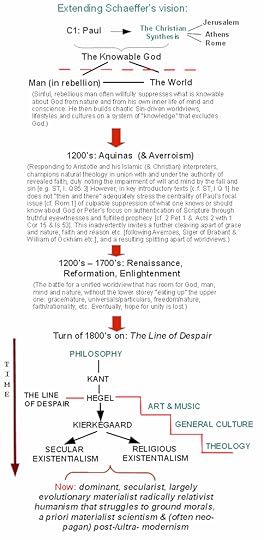 Extending (and correcting) Schaeffer’s vision of the course of western thought, worldviews and culture, C1 – 21
Extending (and correcting) Schaeffer’s vision of the course of western thought, worldviews and culture, C1 – 21Schaeffer thought that once there was an upper/lower storey approach that in effect gave up on solving the problem of the one and the many, the lower storey would eat up the upper one, unity and coherence would disintegrate:
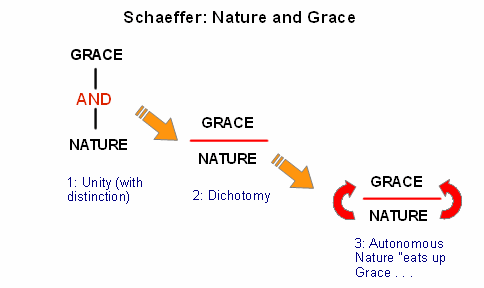 Dichotomising nature and grace leads to disjointedness in western man’s worldview
Dichotomising nature and grace leads to disjointedness in western man’s worldviewSchaeffer and others also thought in terms of the seven mountains picture of the span of culture, how the dominant view sets the agenda and how cultures therefore change. This has been championed by Wallnau and others in recent years. I adapt:
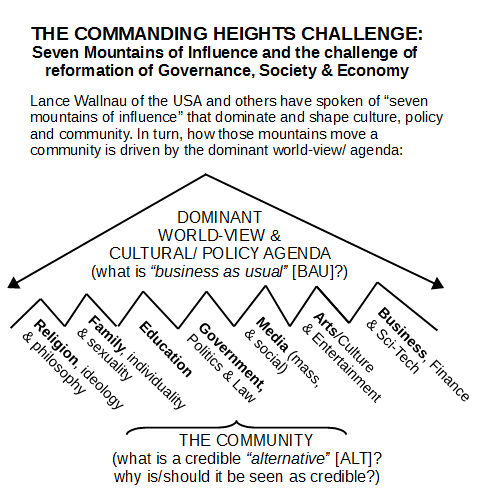
We may carry this onward to the challenge to speak into the culture prophetically, from a gospel based, worldviews informed sound perspective rooted in “The God who is there and who is not silent”:
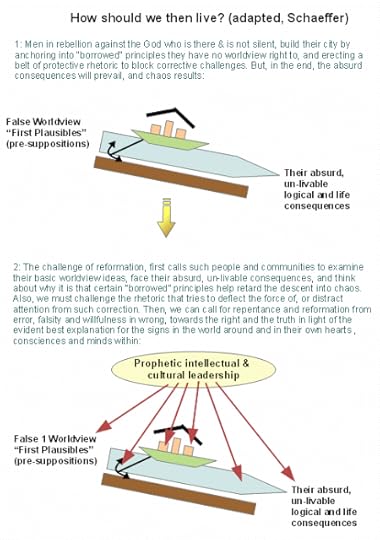
In our time, all of this is complicated by complex geostrategic issues:
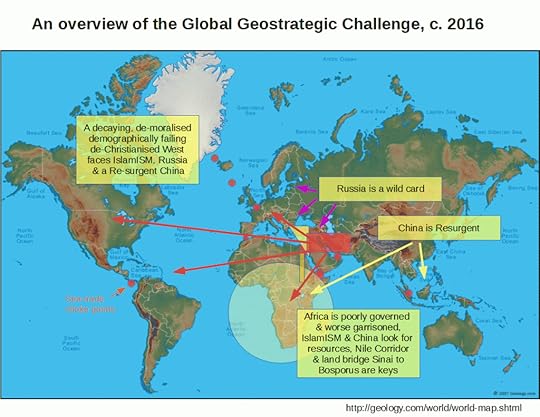
Food for thought. END
Copyright © 2022 Uncommon Descent . This Feed is for personal non-commercial use only. If you are not reading this material in your news aggregator, the site you are looking at is guilty of copyright infringement UNLESS EXPLICIT PERMISSION OTHERWISE HAS BEEN GIVEN. Please contact legal@uncommondescent.com so we can take legal action immediately.Plugin by Taragana
April 1, 2022
Standard Model doubted at Inference Review
Subir Sarkar, Emeritus Professor at the Rudolf Peierls Centre for Theoretical Physics, University of Oxford, offers arguments against the Standard Model in cosmology:
Cosmological data are now routinely corrected by a special-relativity boost transforming the measured redshift and magnitudes of distant objects to the presumptively isotropic cosmic rest frame. In the cosmic microwave background frame, the large-scale averaged distribution of matter is also assumed to be isotropic. The Friedmann–Lemaître equations can then be applied to the transformed magnitudes and red shifts…
These assumptions are no longer tenable. Several independent data sets now argue against the existence of a cosmic rest frame. At low redshift (z ≲ 0.1), all matter in our local supercluster of galaxies has a coherent bulk flow approximately aligned with the direction of the cosmic microwave background dipole: no convergence to the cosmic rest frame is seen on scales as large as ~300/h Mpc. At high redshift (z > 1), the observed dipole in the sky-distribution of distant radio sources and quasars is significantly larger than expected according to the kinematic interpretation of the cosmic microwave background dipole. Phenomena are in conflict with the cosmological principle. They directly challenge the claim that the universe is dominated by vacuum energy, which rests on its assumed large-scale homogeneity and isotropy. These are potentially paradigm-changing developments.
Subir Sarkar, “Heart of Darkness” at Inference Review (March 2022)
People whose views are otherwise disparate are saying the same thing:
Rob Sheldon On The New Evidence Against The Standard Model In Cosmology: “The Party’s Over.”
and
Sabine Hossenfelder: New evidence against the Standard Model of cosmology
Copyright © 2022 Uncommon Descent . This Feed is for personal non-commercial use only. If you are not reading this material in your news aggregator, the site you are looking at is guilty of copyright infringement UNLESS EXPLICIT PERMISSION OTHERWISE HAS BEEN GIVEN. Please contact legal@uncommondescent.com so we can take legal action immediately.Plugin by Taragana
Do genetics and homology really support Darwinism where the fossil record has failed?
ID explainer Lukas Rueger takes that on:
Perhaps with that distressing reality in mind, Richard Dawkins and others have said that the case for Darwinian evolution is perfectly sound even without fossils. Evolutionists, instead, have all the evidence they need in genes and morphology to draw the one true tree of life. In Episode 4, which is out today, Lukas asks, “Do Homology and Phylogenetics REALLY Support Darwin’s Tree of Life?” The problem is that the “trees” thus sketched are full of fundamental, mutual contradictions. Even if universal common ancestry is true, there seemingly is no drawable “true tree.” As Lukas says, “Those who study homology simply assume evolution to be true, but they’ve never actually demonstrated that the ancestral evolutionary relationships between different organisms are real.”
David Klinghoffer, “Lukas Ruegger: Homology and Phylogenetics Topple Darwin’s Tree” at Evolution News and Science Today (March 30, 2022)
You may also wish to read: Can the Cambrian Explosion be explained away by the earlier Ediacaran Explosion? David Klinghoffer: Lukas Ruegger is the personable new intelligent design “explainer” whose videos take an approach similar to Khan Academy’s. The latter’s offering on evolution is replete with junk science, as Casey Luskin has detailed. Ruegger’s treatment of the subject is much better, and I appreciate his clarity and brevity.
and
Why punctuated equilibrium did not rescue modern evolutionary theory, with Lukas Ruegger. Re Stephen Jay Gould returning to traditional Darwinism: Didn’t E. O. Wilson try escaping the vice grip of Darwinism with “group selection” and then dramatically returning to full orthodoxy, leaving many dozens of supporters stranded? Complete academy acceptance is a powerful motivator…
Copyright © 2022 Uncommon Descent . This Feed is for personal non-commercial use only. If you are not reading this material in your news aggregator, the site you are looking at is guilty of copyright infringement UNLESS EXPLICIT PERMISSION OTHERWISE HAS BEEN GIVEN. Please contact legal@uncommondescent.com so we can take legal action immediately.Plugin by Taragana
Evolutionary genomics with Richard Buggs: Why flowering plants are a mystery
Evolutionary biologist Richard Buggs will give a talk, asking Why are flowers a biological mystery? Tuesday, April 5, 2022, at 11:30 am. GMT-7 (Time zones.)
We could not exist without flowering plants, but to this date researchers cannot explain where they came from. Why did Darwin describe the origin of flowering plants as an “abominable mystery”?
Charles Darwin was convinced that the evolution of complexity must proceed by tiny steps. Only tiny steps could be accumulated by natural selection. The process had to go slowly for it to work. Billions of years were needed. But Darwin was aware that this theory had a problem: flowers.
Flowering plants appear so suddenly in the fossil record, in such diversity, that their origin seems to be at odds with Darwin’s theory. When writing a letter to his friend Joseph Hooker in 1879, Darwin famously described this problem as an “abominable mystery”. To this date, evolutionary biologists still have not been able to solve this mystery.
Richard Buggs, Professor of Evolutionary Genomics at Queen Mary University of London, will join us at The Garden to reveal how the problem changed over time and why we still haven’t managed to solve it.
Darwin wasn’t the only one to notice. Sherlock Holmes’s creator, Arthur Conan Doyle, put these words in his best-known character’s mouth:
What a lovely thing a rose is!
He walked past the couch to the open window and held up the drooping stalk of a moss-rose, looking down at the dainty blend of crimson and green. It was a new phase of his character to me, for I had never before seen him show any keen interest in natural objects.
‘There is nothing in which deduction is so necessary as in religion,” said he, leaning with his back against the shutters. “It can be built up as an exact science by the reasoner. Our highest assurance of the goodness of Providence seems to me to rest in the flowers. All other things, our powers, our desires, our food, are all really necessary for our existence in the first instance. But this rose is an extra. Its smell and its colour are an embellishment of life, not a condition of it. It is only goodness which gives extras, and so I say again that we have much to hope from the flowers.” – The Naval Treaty
There are number of YouTube vids advising that the mystery has been or soon will be solved. Enjoy. Believe. Whatever.
You may also wish to read: Dawkins’s Thesis That The Bacterial Flagellum Evolved From The Injectisome Is No Longer Tenable, Prof Says. “According to a Queen Mary U evolutionary genomics prof writing at Nature Ecology & Evolution, Richard Dawkins’s claim that the bacterial flagellum evolved from the injectisome “is no longer sustainable.”
Copyright © 2022 Uncommon Descent . This Feed is for personal non-commercial use only. If you are not reading this material in your news aggregator, the site you are looking at is guilty of copyright infringement UNLESS EXPLICIT PERMISSION OTHERWISE HAS BEEN GIVEN. Please contact legal@uncommondescent.com so we can take legal action immediately.Plugin by Taragana
At Mind Matters News: New Scientist offers a sympathetic account of panpsychism
New Scientist? Yes. A serious, longform article shows that physicalism (“the mind is just what the brain does”) is failing:
Panpsychism, the view that all nature participates in consciousness, has been growing under the radar for some time in science. But it is now coming into plainer view. New Scientist is one of the last places one might have expected to find a serious, long-form account of panpsychism — one that, in the context, amounts to a defense.
Yet that’s just what science writer and filmmaker Thomas Lewton has been permitted by the editors to do. He tells us about his own journey at his site: “Studying physics, I thought telescopes and particle colliders would offer firm answers, but instead they raised more questions.”
And at New Scientist, he tells us why…
A surprising number of physicists are rethinking all that, “convinced that we will never make sense of the universe’s mysteries – things like how reality emerges from the fog of the quantum world and what the passage of time truly signifies – unless we reimagine the relationship between matter and mind.” Which, they realize, can’t be done simply by eliminating the mind from science thinking.
News, “New Scientist offers a sympathetic account of panpsychism” at Mind Matters News
Now that is a shift.
Takehome: When even alternative views that science writer Thomas Lewton profiles seem like panpsychism, physics is clearly learning to live with the mind’s reality.
You may also wish to read: Why panpsychism is starting to push out naturalism. A key goal of naturalism/materialism has been to explain human consciousness away as “nothing but a pack of neurons.” That can’t work. Panpsychism is not dualism. By including consciousness — including human consciousness — as a bedrock fact of nature, it avoids naturalism’s dead end.
Copyright © 2022 Uncommon Descent . This Feed is for personal non-commercial use only. If you are not reading this material in your news aggregator, the site you are looking at is guilty of copyright infringement UNLESS EXPLICIT PERMISSION OTHERWISE HAS BEEN GIVEN. Please contact legal@uncommondescent.com so we can take legal action immediately.Plugin by Taragana
To get change, create or exploit a crisis . . .
to control the change, set the agenda and control thought to a thesis, an antithesis and your desired synthesis. So, we see, in a cartoon:
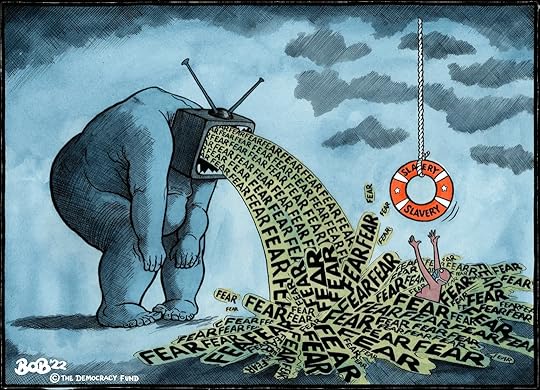
Where, let us recall the change challenge:
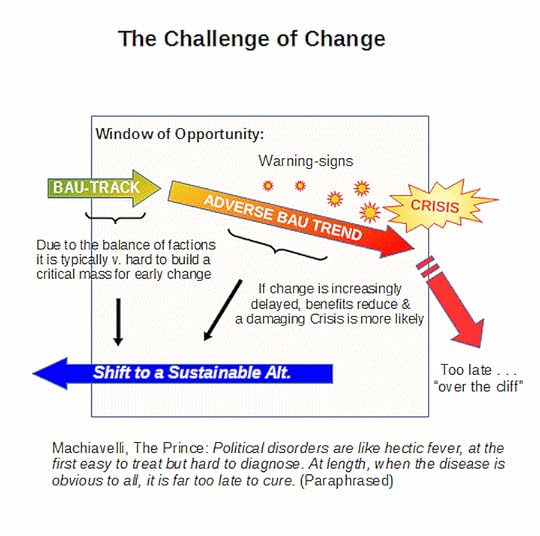
. . . thus the fallacy of the false dilemma pushing a simplistic dichotomy of choices:

. . . and the Overton Window context, where one has to open up space to pull policy, likely incrementally — thus we see a slippery slope ratchet:
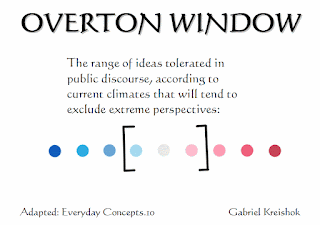
so, we see how a slippery slope slide into lawless oligarchy can be created:
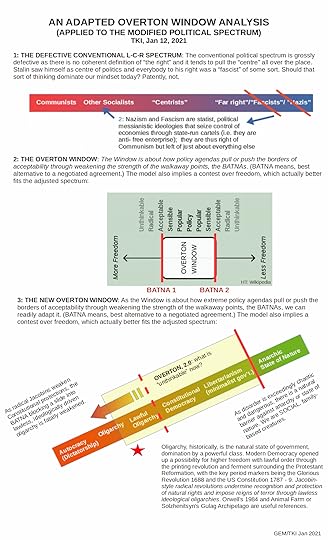
Are we facing a march of the Lemmings?
 Of Lemmings, marches of folly and cliffs of self-falsifying absurdity . . .
Of Lemmings, marches of folly and cliffs of self-falsifying absurdity . . . Food for thought as we contemplate technoplutocracy. END
Copyright © 2022 Uncommon Descent . This Feed is for personal non-commercial use only. If you are not reading this material in your news aggregator, the site you are looking at is guilty of copyright infringement UNLESS EXPLICIT PERMISSION OTHERWISE HAS BEEN GIVEN. Please contact legal@uncommondescent.com so we can take legal action immediately.Plugin by Taragana
Michael J. Behe's Blog
- Michael J. Behe's profile
- 219 followers



